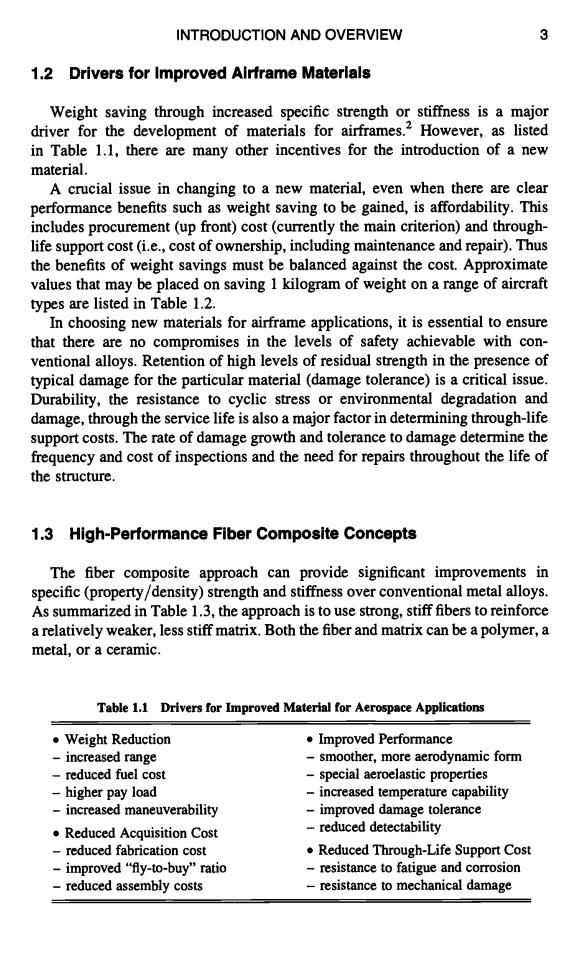正在加载图片...

INTRODUCTION AND OVERVIEW 3 1.2 Drivers for Improved Airframe Materlals Weight saving through increased specific strength or stiffness is a major driver for the development of materials for airframes.2 However,as listed in Table 1.1,there are many other incentives for the introduction of a new material. A crucial issue in changing to a new material,even when there are clear performance benefits such as weight saving to be gained,is affordability.This includes procurement (up front)cost(currently the main criterion)and through- life support cost(i.e.,cost of ownership,including maintenance and repair).Thus the benefits of weight savings must be balanced against the cost.Approximate values that may be placed on saving 1 kilogram of weight on a range of aircraft types are listed in Table 1.2. In choosing new materials for airframe applications,it is essential to ensure that there are no compromises in the levels of safety achievable with con- ventional alloys.Retention of high levels of residual strength in the presence of typical damage for the particular material (damage tolerance)is a critical issue. Durability,the resistance to cyclic stress or environmental degradation and damage,through the service life is also a major factor in determining through-life support costs.The rate of damage growth and tolerance to damage determine the frequency and cost of inspections and the need for repairs throughout the life of the structure. 1.3 High-Performance Fiber Composite Concepts The fiber composite approach can provide significant improvements in specific(property/density)strength and stiffness over conventional metal alloys. As summarized in Table 1.3,the approach is to use strong,stiff fibers to reinforce a relatively weaker,less stiff matrix.Both the fiber and matrix can be a polymer,a metal,or a ceramic. Table 1.1 Drivers for Improved Material for Aerospace Applications ·Weight Reduction Improved Performance -increased range -smoother,more aerodynamic form -reduced fuel cost -special aeroelastic properties -higher pay load -increased temperature capability -increased maneuverability -improved damage tolerance .Reduced Acquisition Cost -reduced detectability -reduced fabrication cost Reduced Through-Life Support Cost -improved“"Hy-to-buy”ratio resistance to fatigue and corrosion -reduced assembly costs -resistance to mechanical damageINTRODUCTION AND OVERVIEW 3 1.2 Drivers for Improved Airframe Materials Weight saving through increased specific strength or stiffness is a major driver for the development of materials for airframes. 2 However, as listed in Table 1.1, there are many other incentives for the introduction of a new material. A crucial issue in changing to a new material, even when there are clear performance benefits such as weight saving to be gained, is affordability. This includes procurement (up front) cost (currently the main criterion) and throughlife support cost (i.e., cost of ownership, including maintenance and repair). Thus the benefits of weight savings must be balanced against the cost. Approximate values that may be placed on saving 1 kilogram of weight on a range of aircraft types are listed in Table 1.2. In choosing new materials for airframe applications, it is essential to ensure that there are no compromises in the levels of safety achievable with conventional alloys. Retention of high levels of residual strength in the presence of typical damage for the particular material (damage tolerance) is a critical issue. Durability, the resistance to cyclic stress or environmental degradation and damage, through the service life is also a major factor in determining through-life support costs. The rate of damage growth and tolerance to damage determine the frequency and cost of inspections and the need for repairs throughout the life of the structure. 1.3 High-Performance Fiber Composite Concepts The fiber composite approach can provide significant improvements in specific (property/density) strength and stiffness over conventional metal alloys. As summarized in Table 1.3, the approach is to use strong, stiff fibers to reinforce a relatively weaker, less stiff matrix. Both the fiber and matrix can be a polymer, a metal, or a ceramic. Table 1.1 Drivers for Improved Material for Aerospace Applications • Weight Reduction • Improved Performance - increased range - smoother, more aerodynamic form - reduced fuel cost - special aeroelastic properties - higher pay load - increased temperature capability - increased maneuverability - improved damage tolerance • Reduced Acquisition Cost - reduced detectability - reduced fabrication cost • Reduced Through-Life Support Cost - improved "fly-to-buy" ratio - resistance to fatigue and corrosion - reduced assembly costs - resistance to mechanical damage